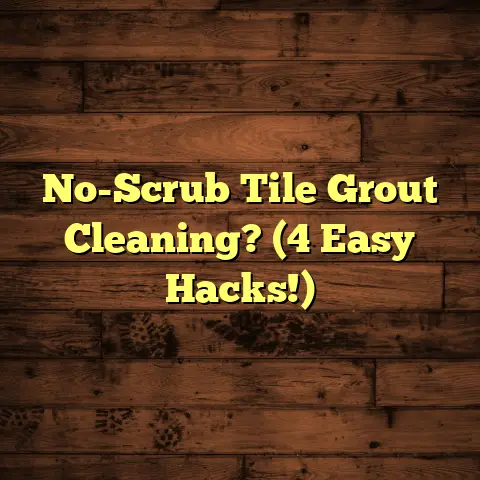Glue Carpet Tiles To Concrete: Pro Secrets (5 Tools!)
Ever tried a home improvement project that went sideways?
I’m talking about the kind where you envision a beautiful transformation, but end up with more frustration than fabulousness.
I remember one time, my buddy tried gluing carpet tiles to his basement concrete floor.
Let’s just say it involved a lot of cursing, tiles stuck to his socks, and a very unhappy wife. The moral of the story?
Having the right tools and know-how is everything. So, let’s dive into the world of carpet tiles and concrete!
Why Choose Carpet Tiles?
Let’s face it, traditional carpeting can be a nightmare. Stains, smells, and the dreaded “carpet monster” that lurks beneath – you know, the one that eats socks and small toys.
Carpet tiles, on the other hand, are like the superhero of flooring. As a flooring contractor with over 15 years of experience, I’ve seen first-hand the benefits:
-
Easy Installation: Forget wrestling with massive rolls of carpet. Carpet tiles are manageable and can be installed by just about anyone.
-
Design Versatility: Mix and match colors, create patterns, and customize your space like a flooring Picasso.
-
Individual Tile Replacement: Spill red wine? No problem! Just pop out the stained tile and replace it with a fresh one. This is a huge money-saver compared to replacing an entire carpet. According to the CRI (Carpet and Rug Institute), carpet tile replacement can save up to 50% compared to full carpet replacement over the lifespan of the flooring.
Think of carpet tiles as Legos for your floor.
You can create anything you want, and if you mess up, it’s easy to fix.
The Importance of Concrete Preparation
Now, before you start slapping those tiles down, let’s talk concrete prep. This is crucial.
Imagine trying to paint a car with mud caked on it. The paint won’t stick, right? Same principle applies here.
Here’s what you need to do:
-
Cleaning: Sweep, vacuum, and scrub the concrete to remove dirt, dust, and debris. I like to use a concrete degreaser to get rid of any oil or grease stains.
-
Patching Cracks: Concrete floors often resemble Swiss cheese with cracks and holes. Use a concrete patching compound to fill these in. Let it dry completely and sand it smooth.
-
Moisture Testing: This is where things get serious. Concrete is porous and can hold moisture, which can ruin your adhesive and lead to mold growth. A simple moisture meter (available at most hardware stores) will tell you if the concrete is dry enough. Aim for a reading below 4% moisture content. You can also use the plastic sheet test: Tape a 2’x2′ piece of clear plastic to the floor. After 24 hours, check for moisture under the plastic. If there’s moisture, the concrete needs more drying time.
Pro Tip: Use a dehumidifier to speed up the drying process.
The 5 Essential Tools for Installation
Alright, let’s talk tools. These are the weapons you’ll need in your carpet tile arsenal.
-
Adhesive
Choosing the right adhesive is like finding the perfect partner – it needs to be a good match. There are several types to choose from:
-
Pressure-Sensitive Adhesive: This is like double-sided tape on steroids. It’s easy to use and allows you to reposition tiles if needed.
-
Wet-Set Adhesive: This type requires you to apply the adhesive and then immediately place the tiles. It provides a stronger bond than pressure-sensitive adhesive.
-
Spray Adhesive: Convenient for quick application, but may not provide as strong a bond as other types.
-
My Recommendation: I personally prefer a high-quality pressure-sensitive adhesive for most residential applications. It’s forgiving and provides a strong, long-lasting bond. Look for an adhesive specifically designed for carpet tiles and concrete.
I once had a client who tried using regular craft glue for his carpet tiles. Let’s just say his floor looked like a patchwork quilt made of loose tiles. Don’t be that guy.
-
-
Notched Trowel
A notched trowel is a flat, rectangular tool with notches cut into one or more edges.
It’s essential for applying adhesive evenly. The notches control the amount of adhesive that’s applied, ensuring a consistent bond.
- Why is it important? Applying too much adhesive can create a mess and make the tiles squish out. Applying too little can result in tiles that don’t stick properly. The notched trowel ensures you get it just right.
I remember a DIYer trying to spread adhesive with a butter knife. The result? A gloppy, uneven mess. Invest in a notched trowel, trust me.
-
Carpet Tile Cutter
Cutting carpet tiles with scissors is like trying to eat soup with a fork – possible, but not ideal. A carpet tile cutter makes clean, precise cuts, saving you time and frustration.
-
Types of Cutters:
-
Utility Knife: Good for simple straight cuts.
-
Carpet Knife: Has a curved blade for easier cutting.
-
Guillotine Cutter: A tabletop cutter that makes precise, straight cuts.
-
I once saw someone trying to cut carpet tiles with a dull kitchen knife. It was like watching a cooking show gone horribly wrong.
-
-
Measuring Tape
This one’s a no-brainer, but it’s worth emphasizing. Accurate measurements are crucial for avoiding mistakes. Remember the old saying: “Measure twice, cut once.”
I like to add a little twist: “Measure twice, cut once, then measure again just to be sure.”
Pro Tip: Use a laser measure for large rooms. It’s faster and more accurate than a traditional tape measure.
-
Seam Roller
A seam roller is a small, handheld tool used to press the edges of carpet tiles together, ensuring they adhere properly and create a seamless look.
It’s like the finishing touch that makes your floor look professional.
- Why is it important? Without a seam roller, the edges of the tiles may curl up or separate over time.
I once saw someone trying to use a rolling pin to roll the seams. It didn’t work. Get a seam roller – it’s worth it.
Step-by-Step Installation Guide
Okay, you’ve got your tools, your concrete is prepped, and you’re ready to roll (pun intended!). Here’s a step-by-step guide to installing carpet tiles:
-
Planning: Start by measuring your room and planning the layout. Decide where you want to start and how you want to arrange the tiles. I like to start in the center of the room and work my way outwards. This ensures that any partial tiles will be along the edges, where they’re less noticeable.
-
Dry Fit: Before you start gluing, lay out the tiles in a “dry fit” to make sure everything lines up and that you’re happy with the layout. This is your chance to make any adjustments before the adhesive comes into play.
-
Applying Adhesive: Using your notched trowel, apply the adhesive to a small section of the floor. Follow the manufacturer’s instructions for the correct amount and drying time.
-
Placing Tiles: Carefully place the tiles onto the adhesive, pressing them firmly into place. Make sure the edges are aligned and that there are no gaps.
-
Cutting Tiles: When you reach the edges of the room, you’ll need to cut the tiles to fit. Measure the space and use your carpet tile cutter to make precise cuts.
-
Rolling Seams: Once all the tiles are in place, use your seam roller to press the edges together, ensuring a seamless look.
-
Clean Up: Remove any excess adhesive and clean the floor with a damp cloth.
Humor Break: Remember, patience is key. Don’t rush the process, and don’t be afraid to take breaks. Carpet tile installation should be enjoyable, not a source of stress. And for goodness sake, avoid carpet tile-related injuries!
Common Mistakes and How to Avoid Them
Even with the best preparation, mistakes can happen. Here are some common pitfalls and how to avoid them:
-
Not Preparing the Concrete Properly: This is the biggest mistake people make. Make sure your concrete is clean, dry, and free of cracks and debris.
-
Using the Wrong Adhesive: As I mentioned before, choosing the right adhesive is crucial. Use an adhesive specifically designed for carpet tiles and concrete.
-
Not Measuring Accurately: Double-check your measurements before cutting any tiles. A small mistake can throw off the entire layout.
-
Applying Too Much Adhesive: This can create a mess and make the tiles squish out. Use a notched trowel to apply the adhesive evenly.
-
Not Rolling the Seams: This can result in tiles that curl up or separate over time. Use a seam roller to press the edges together.
Humor Break: I once had a client who skipped the concrete prep and ended up in a “battle of the sticky tiles.” It involved a lot of yelling, a crowbar, and a very messy divorce from his flooring project. Don’t let that be you!
Maintaining Your Carpet Tiles
Once your carpet tiles are installed, you’ll want to keep them looking their best. Here are some maintenance tips:
-
Vacuum Regularly: Vacuum your carpet tiles at least once a week to remove dirt and debris.
-
Spot Clean Stains: Clean up spills immediately with a damp cloth and a mild detergent.
-
Replace Damaged Tiles: If a tile becomes stained or damaged, simply pop it out and replace it with a new one.
-
Deep Clean Occasionally: Once a year, consider deep cleaning your carpet tiles with a carpet cleaner.
Humor Break: I once found a lost diamond earring while vacuuming my carpet tiles. Who knew maintenance could be so rewarding?
Conclusion
So, there you have it – the pro secrets to gluing carpet tiles to concrete. With the right tools, preparation, and a healthy dose of humor, you can transform your space and avoid the pitfalls of DIY disasters.
Remember, flooring projects can be challenging, but they’re also incredibly rewarding.
So, grab your tools, put on some music, and get ready to create a floor you’ll love for years to come! And if you need a professional floor contractor, you know who to call!





